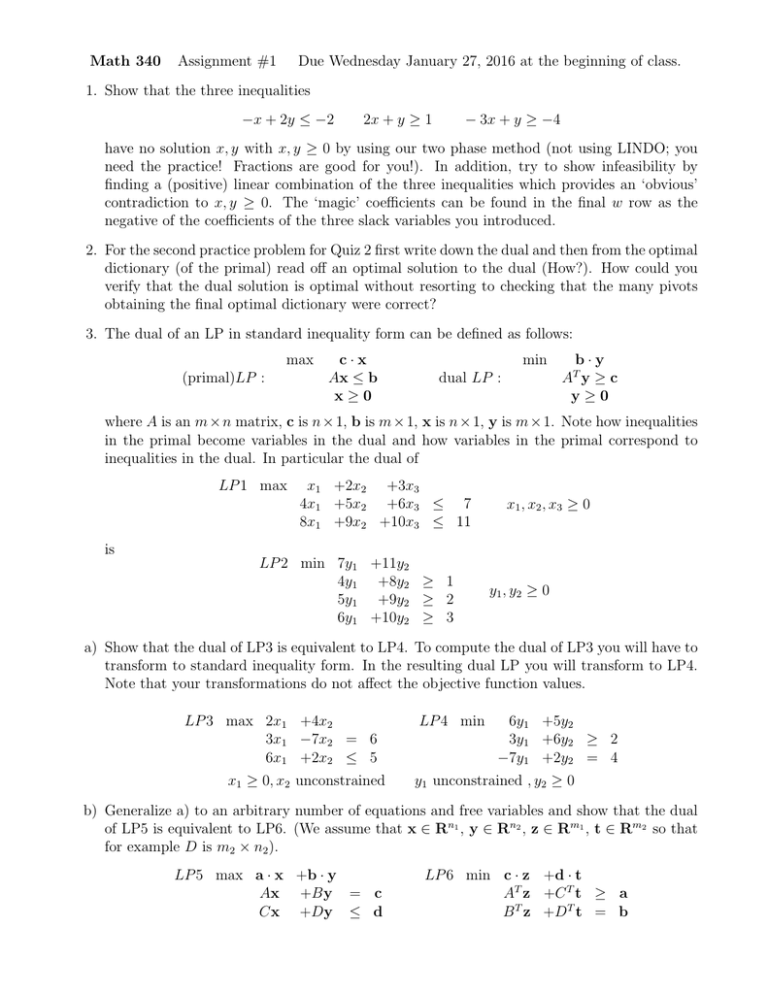Math 340 Assignment #1 1. Show that the three inequalities
advertisement

Math 340
Assignment #1
Due Wednesday January 27, 2016 at the beginning of class.
1. Show that the three inequalities
−x + 2y ≤ −2
2x + y ≥ 1
− 3x + y ≥ −4
have no solution x, y with x, y ≥ 0 by using our two phase method (not using LINDO; you
need the practice! Fractions are good for you!). In addition, try to show infeasibility by
finding a (positive) linear combination of the three inequalities which provides an ‘obvious’
contradiction to x, y ≥ 0. The ‘magic’ coefficients can be found in the final w row as the
negative of the coefficients of the three slack variables you introduced.
2. For the second practice problem for Quiz 2 first write down the dual and then from the optimal
dictionary (of the primal) read off an optimal solution to the dual (How?). How could you
verify that the dual solution is optimal without resorting to checking that the many pivots
obtaining the final optimal dictionary were correct?
3. The dual of an LP in standard inequality form can be defined as follows:
max
(primal)LP :
c·x
Ax ≤ b
x≥0
min
b·y
A y≥c
y≥0
T
dual LP :
where A is an m × n matrix, c is n × 1, b is m × 1, x is n × 1, y is m × 1. Note how inequalities
in the primal become variables in the dual and how variables in the primal correspond to
inequalities in the dual. In particular the dual of
LP 1 max
x1 +2x2 +3x3
4x1 +5x2 +6x3 ≤ 7
8x1 +9x2 +10x3 ≤ 11
x1 , x2 , x3 ≥ 0
is
LP 2 min 7y1 +11y2
4y1 +8y2 ≥ 1
5y1 +9y2 ≥ 2
6y1 +10y2 ≥ 3
y1 , y2 ≥ 0
a) Show that the dual of LP3 is equivalent to LP4. To compute the dual of LP3 you will have to
transform to standard inequality form. In the resulting dual LP you will transform to LP4.
Note that your transformations do not affect the objective function values.
LP 3 max 2x1 +4x2
3x1 −7x2 = 6
6x1 +2x2 ≤ 5
x1 ≥ 0, x2 unconstrained
LP 4 min
6y1 +5y2
3y1 +6y2 ≥ 2
−7y1 +2y2 = 4
y1 unconstrained , y2 ≥ 0
b) Generalize a) to an arbitrary number of equations and free variables and show that the dual
of LP5 is equivalent to LP6. (We assume that x ∈ Rn1 , y ∈ Rn2 , z ∈ Rm1 , t ∈ Rm2 so that
for example D is m2 × n2 ).
LP 5 max a · x +b · y
Ax +By = c
Cx +Dy ≤ d
LP 6 min c · z +d · t
AT z +C T t ≥ a
B T z +DT t = b
x ≥ 0, y all free
z all free , t ≥ 0
The general rule is that equalities in one LP transform to free variables in its dual and free
variables in one LP transform to equalities in its dual.
4. We say a set C of points in Rn is convex
segment joining x and y are in C. Thus C
λ ∈ (0, 1). then λx + (1 − λ)y ∈ C. Let A
Show that
F = {x ∈ Rn
if for every pair x, y ∈ C, all points on the line
is a convex set if for every pair x, y ∈ C and any
be an m × n matrix and b a given vector in Rm .
: Ax ≤ b,
x ≥ 0}
is a convex set. When you begin to think of this problem you should understand that λa +
(1 − λ)b for λ ∈ [0, 1] is a weighted average of a and b and the set {λu + (1 − λ)v : λ ∈
[0, 1]} = {v + λ(u − v) : λ ∈ [0, 1]} is the line segment joining u and v.
5. Consider an LP: max c · x such that Ax ≤ b and x ≥ 0. Assume the LP has two optimal
solutions u and v. Show that for any choice of λ ∈ [0, 1] (i.e. 0 ≤ λ ≤ 1), that λu + (1 − λ)v
is also an optimal solution. First show that λu + (1 − λ)v has the same value of the objective
function as u. Then show λu + (1 − λ)v is a feasible solution to the LP.
6. Consider an LP: max c · x such that Ax ≤ b and x ≥ 0. Assume the LP is unbounded
namely there is a parametrized set of feasible solutions z(t) = y + tu for some choice of y, u
where
lim c · z(t) = ∞
t→∞
(this is what our simplex algorithm spits out.) Show that this means Au ≤ 0 and c · u > 0.
Also show the converse, namely that if an LP {max c · x such that Ax ≤ b and x ≥ 0} has
a feasible solution z and there exists a vector v with Av ≤ 0 and c · v > 0, then the LP is
unbounded.






